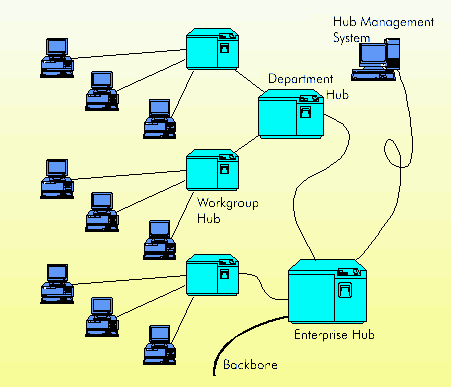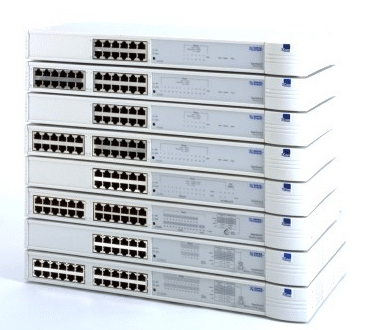hub
The term hub is used in local area networks and in satellite transmission. In satellite communications, it is a large, fixed ground station that provides the connection between the communications networks and the satellite.
In local area networks( LAN), a hub is a multi- port repeater between LAN segments and terminals. It forms the concentration point or network node for star-shaped cabling to form logical LANs, i.e. the hub adapts different LANs and any media. For this reason, it is also referred to as "wiring hubs" or cable concentrators.
Hubs operate exclusively on the physical layer, they receive the signals, regenerate them, compensate for temporal signal shifts caused by jitter and send the signals to all network nodes.
Conceptual differences between hubs
In terms of application, hubs can be divided into workgroup-wide (workgroup), department-wide (departmental) and enterprise-wide (enterprise) hubs, which differ in size and equipment.
A workgroup hub can serve only a few dozen stations of a uniform network type. These hubs are primarily used to connect PCs or other end devices to the hierarchically higher departmental or corporate hubs. Examples of workgroup hubs would be a 10Base-T hub for Ethernet or the loop distributor for Token Ring.
Department-wide hubs are typically connected to the enterprise-wide hubs and supported around 100 connectable stations, usually from a single network technology. A larger Ethernet star distributor is an example of a department-wide hub.
Enterprise-wide hubs use modular technology and can implement different LAN types, e.g., connecting Token Ring, Ethernet and FDDI. Depending on the configuration of the hub modules, a few hundred stations in each network can be connected to an enterprise-wide hub. There is a practically unlimited variety of modules; they offer the functionalities of concentrator, bridge, router or management system and support network management as well as all common transmission media.
Hubs as network nodes of the physical layer
The heart of the hub is the internal buses that form the backplane. In addition to the pure number of slots, it is primarily the bus architecture that determines the hub's performance. Today's hubs virtually all operate with proprietary buses, where capacity allocation ( arbitration) is determined by the access method running on the bus, i.e. tokens, the CSMA/ CD method or FDDI. The proprietary bus of a hub transports the signals as if on its own network. There are four basic designs for the backplane of an enterprise-wide hub: the segmented proprietary bus, multiple proprietary buses, multiplexed proprietary buses, and system buses.
The segmented proprietary bus is divided into specific areas for supporting Ethernet, Token Ring, or FDDI, for example. A module plugged onto the segmented proprietary bus notices whether a segment is free or not. If the segment is free, the module can try to switch to another segment or join the network already existing by connecting other modules. In this way modules for different network types can use the same bus.


